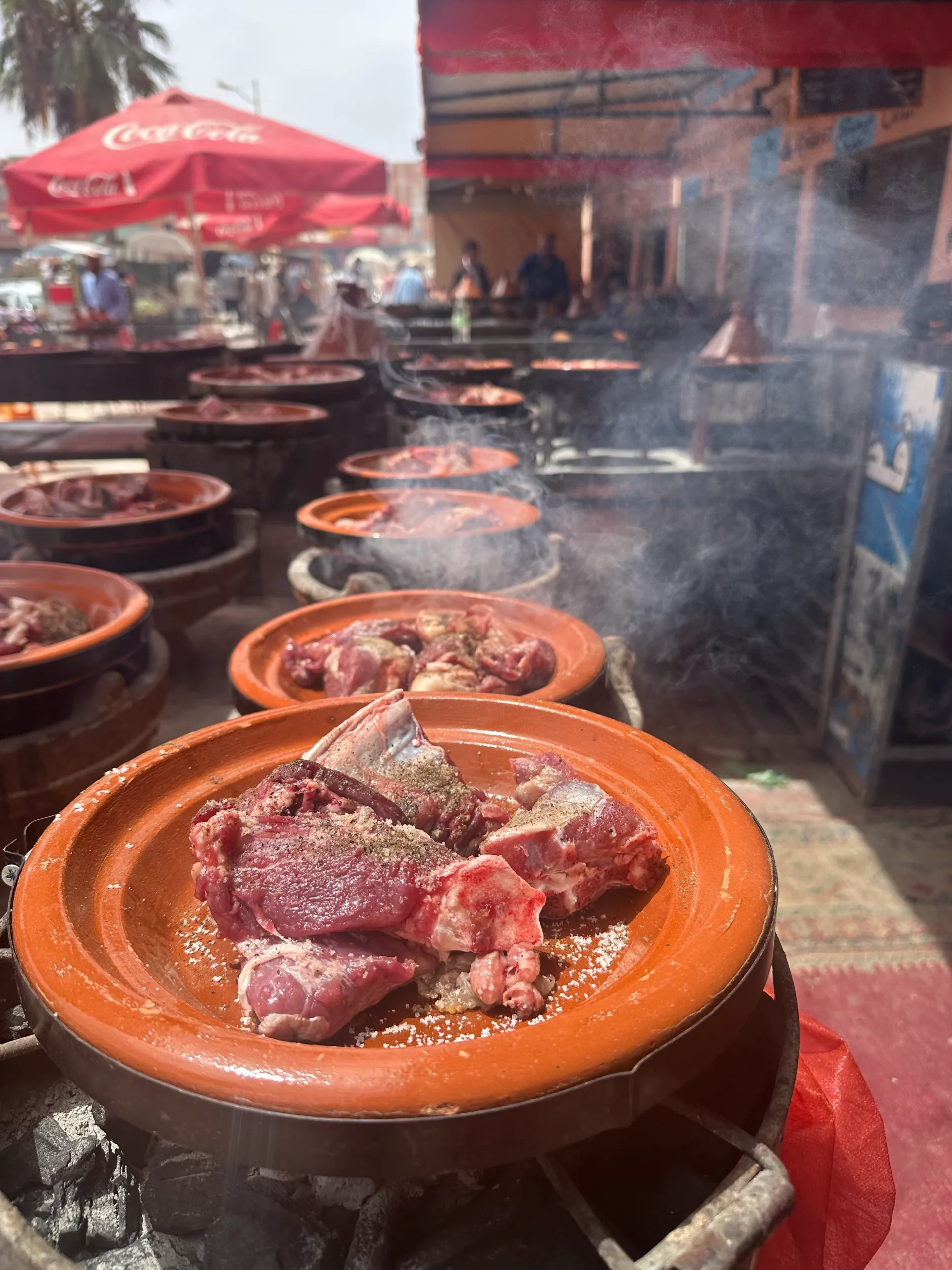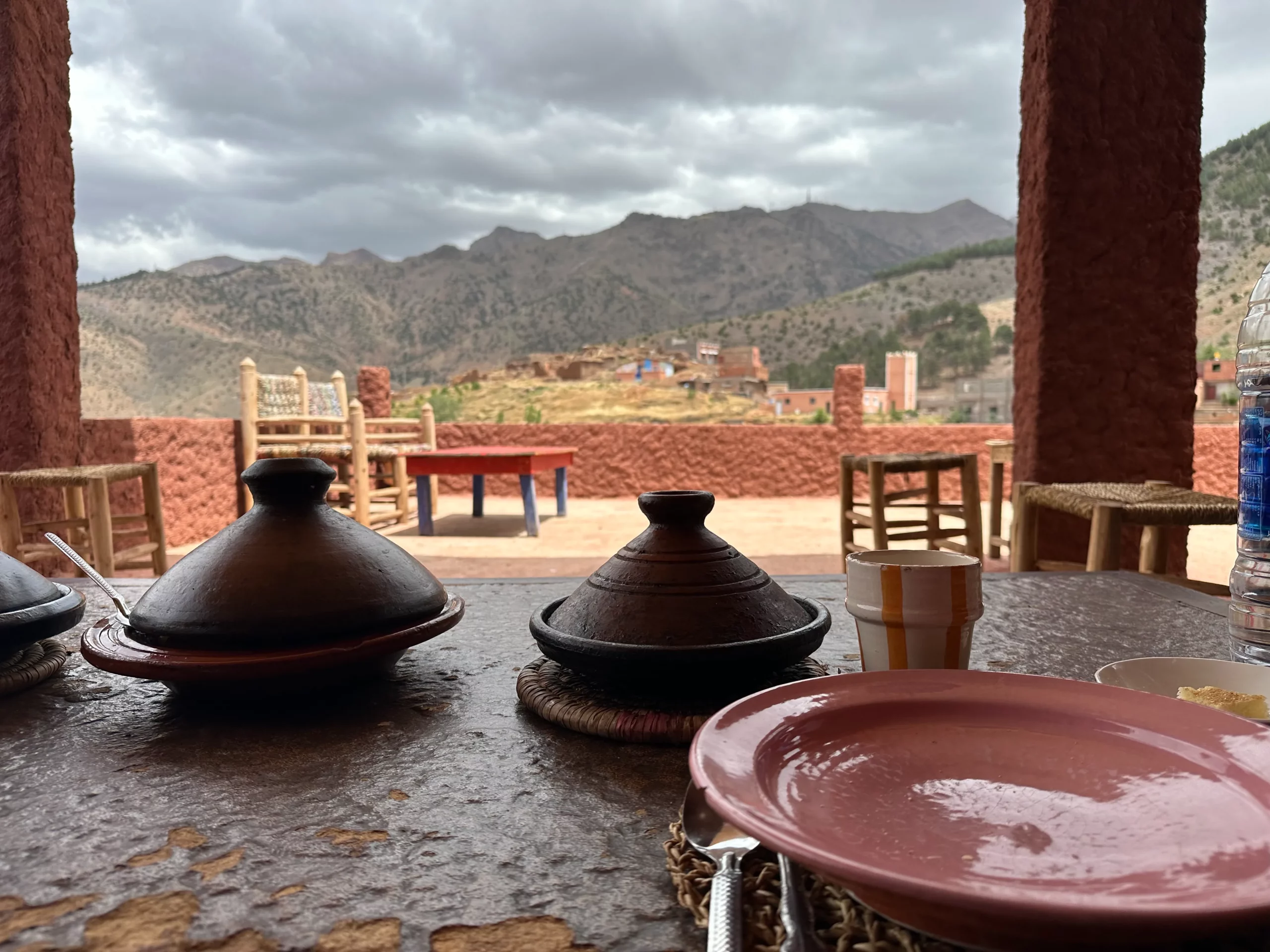Tajine Morocco: The Story of a Nation in a Single Pot
Discover the rich history, culture, and flavors of Morocco through its most iconic culinary creation

Lift the conical lid of a Moroccan tajine, and you are greeted not just by a meal, but by an overture. A plume of steam, thick with the scent of saffron, ginger, and slow-cooked onions, escapes into the air. Below, a vibrant stew bubbles with a quiet symphony, the colors as rich and warm as a Marrakech sunset. This is more than dinner; it is the scent of welcome, an invitation into the heart of a home and a culture.
The word tajine itself holds a duality, referring to both the iconic earthenware cooking vessel and the luscious stew prepared within it. To understand this single dish—in all its history, science, and soul—is to begin to understand the story of Morocco itself, a nation simmered to perfection through centuries of tradition and influence.
From Nomad’s Necessity to Sultan’s Delight: A History of the Tajine
The Berber Genesis: A Portable Oven for a People on the Move
Long before the arrival of Arab caravans or European colonists, the indigenous Amazigh (Berber) people roamed the vast landscapes of North Africa, from the rugged peaks of the Atlas Mountains to the windswept plains. For these nomadic and semi-nomadic communities, life demanded ingenuity. It was in this crucible of necessity that the tajine pot was born over 2,000 years ago, a masterpiece of practical design.
Imagine a family on the move, setting up camp as the sun dips below the horizon. Fuel is scarce, and water is a precious commodity. The tajine pot was their solution: a portable oven crafted from the very earth they walked upon. Its thick clay walls retained heat efficiently, allowing for a slow, gentle cook over a minimal fire of charcoal or wood embers. Its brilliant conical lid trapped every bit of moisture, tenderizing tough, inexpensive cuts of meat and whatever vegetables were available without needing much water. The earliest Berber tajines were a direct reflection of this life—simple, hearty stews of lamb or goat, seasoned with foraged herbs, a testament to their deep, unwavering connection to the land.
The Layers of History: How Invaders and Traders Shaped a Culinary Icon
The humble Berber stew was destined for a grander future. The history of the tajine dish is a direct allegory for the history of Morocco: a resilient indigenous foundation repeatedly enriched by waves of cultural influence, yet never losing its essential character. Each new arrival left an indelible mark on the nation’s palate.
The Arab Influence (7th Century): With the arrival of Arab dynasties came the fabled spice routes, bringing a treasure trove of new flavors from the East. Cinnamon, ginger, turmeric, cumin, and precious saffron transformed the tajine’s aroma and complexity. Influenced by Persian culinary arts, they also introduced the revolutionary concept of sweet-and-sour pairings, adding dried fruits like prunes, apricots, and dates to savory meat stews—a combination that would become a hallmark of Moroccan cuisine.
The Moorish and Jewish-Moorish Touch: As the Moors migrated from Andalusia (Southern Spain), they brought their agricultural knowledge, establishing groves of olives and citrus trees that would forever change the landscape and the kitchen. Following them, Jewish-Moorish communities introduced their sophisticated preservation techniques, giving Morocco one of its most iconic ingredients: the intensely fragrant and uniquely tangy preserved lemon, a cornerstone of many classic tajine recipes today.
Ottoman and French Echoes: Later influences added subtler notes. The Ottoman presence in North Africa introduced a love for grilled meats (kebabs), which sometimes find their way into modern tajine preparations. The much more recent French protectorate left its mark with a culture of cafés and patisserie, and even inspired the use of enamel coatings on some modern, European-made tajine pots.
Thus, a single bite of a classic Fassi tajine of lamb with prunes and olives is a taste of this layered history. It contains the ancient Berber method of slow-cooking, the aromatic spices of Arab trade, the sweet-and-sour elegance of Persia, and the sun-drenched olives of Andalusia. It is not just a recipe; it is edible history.
The Alchemical Vessel: The Science and Soul of the Tajine Pot
The magic of a tajine lies not only in its ingredients but in the vessel itself. The pot is an alchemical tool, transforming simple components into something extraordinary through a perfect marriage of form and function.
The Magic of the Cone: A Self-Basting Marvel of Engineering
The tajine’s distinctive conical lid is far from decorative; it is a brilliant piece of culinary physics. As the stew gently simmers over low heat, steam rises from the cooking ingredients. This hot, moist air travels up the tall, sloping walls of the cone. As it reaches the cooler top, it condenses back into liquid. Gravity then does its work, and these flavor-infused droplets trickle back down into the shallow base of the pot.
This continuous cycle creates a self-basting system. The food is constantly bathed in its own aromatic juices, resulting in meat that is buttery and fall-off-the-bone tender and vegetables that are succulent and deeply flavorful. This ingenious design concentrates the flavors intensely, all while requiring a minimal amount of water, harking back to its origins in the arid landscapes of North Africa.

The Taste of the Earth: Why Traditional Clay is King
A crucial detail often lost on modern cooks is the material of the pot itself. An authentic Moroccan tajine is crafted from unglazed, porous earthenware. This porosity is key; it allows the pot to “breathe,” ensuring slow, even heat distribution and circulation of steam, which prevents burning and creates a uniquely gentle cooking environment.
More profoundly, the unglazed clay imparts a subtle, unmistakable earthy flavor and aroma to the food—what the French call goût du terroir, or “taste of the earth”. This is the soul of a true tajine, a flavor that cannot be replicated in modern glazed ceramic or cast-iron pots. While convenient and easier to clean, these modern vessels function more like a standard Dutch oven, missing the essential breathing properties and earthy essence of traditional clay. Before its first use, a new clay pot must be seasoned—a ritual of soaking, oiling, and slow baking—to strengthen its structure and prevent it from cracking under heat.
The Heart of the Fire: Cooking with a Majmar
To complete the traditional picture, one must look not just at the pot, but what lies beneath it. Authentically, a tajine is not cooked on a stovetop but over a majmar (or kanoun), a terracotta charcoal brazier. The gentle, consistent, radiant heat from smoldering charcoal is the secret to perfect, hours-long simmering. It allows the flavors to meld without scorching and imparts a faint, smoky perfume that a gas flame or electric coil can never achieve.
The authentic tajine is therefore not just a recipe but a complete culinary ecosystem. It is a harmony of the elements: earth in the form of the clay pot, fire from the charcoal in its own clay brazier, and water managed through the physics of steam. Removing any one of these elements—by using a metal pot or a modern stove—changes the fundamental character of the dish. This explains why a tajine in a Moroccan village often tastes so profoundly different; it is the product of a holistic process, not just a list of ingredients.
A Culinary Atlas: Tasting Morocco’s Regional Tajines
To speak of “a” Moroccan tajine is like speaking of “a” European painting; it ignores a world of diversity. The dish is a culinary chameleon, changing its character with the landscape, the season, and the local culture. Traveling through Morocco is a journey through its many tajines.
| Region | Dominant Flavor Profile | Key Ingredients | Signature Tajine Example |
|---|---|---|---|
| Fez | Sweet & Savory, Complex, Aromatic | Lamb/Beef, Prunes, Apricots, Almonds, Cinnamon, Saffron | Lamb Tagine with Prunes and Almonds |
| Marrakech | Robust, Earthy, Hearty | Beef/Lamb, Kefta (Meatballs), Tomatoes, Eggs, Cumin | Kefta Mkaouara (Meatball Tagine with Eggs) |
| Coastal | Zesty, Herbaceous, Briny | White Fish, Sardines, Calamari, Chermoula, Tomatoes | Fish Tagine with Chermoula and Vegetables |
| South | Aromatic, Sweet, Nutty | Chicken/Lamb, Dates, Figs, Argan Oil, Saffron | Chicken Tagine with Dates and Toasted Almonds |
In Fez, the historic seat of gastronomy, tajines are sophisticated and complex, often showcasing the celebrated sweet-and-savory (mrouzia) style with lamb, prunes, and almonds, perfumed with cinnamon. In bustling Marrakech, the flavors are more robust and earthy. Here you’ll find the beloved kefta tajine, with spiced meatballs simmering in a rich tomato sauce, often with eggs poached right on top. Along the Atlantic coast in cities like Essaouira, the tajine embraces the sea, with fresh fish and calamari cooked in a zesty, herbaceous marinade called chermoula. And in the Saharan south, the dish reflects the oasis, incorporating sweet dates, figs, and the region’s prized argan oil.
More Than a Meal: Tajine as the Heartbeat of Moroccan Life
In Morocco, food is the language of community, and the tajine is its most eloquent expression. It is fundamentally a communal dish, brought to the center of a low table where family and friends gather around, breaking bread and sharing from the same vessel. This act of sharing dissolves boundaries and fosters connection, turning a simple meal into a social ritual.
To be invited to share a tajine is the ultimate gesture of Moroccan hospitality, a tradition deeply ingrained in the culture. The etiquette of eating is just as important. Food is eaten with the thumb and first two fingers of the right hand, as the left is considered unclean. Pieces of crusty Moroccan bread, or khobz, are used as an edible utensil to scoop up the tender meat, vegetables, and rich sauce—no forks required. Diners traditionally eat from the section of the tajine directly in front of them, a sign of respect for the shared space. This communal act, centered around a single pot, physically reinforces a core cultural value: the primacy of the collective. Unlike Western dining with individual plates, the shared tajine creates an interdependent experience, a daily lesson in community and mutual respect.
Insider Tip: And here is a secret that separates the traveler from the tourist: in an authentic Moroccan home, you will almost never find tajine served with couscous. Despite what many restaurants abroad suggest, they are two distinct main courses. Couscous is its own grand affair, traditionally reserved for Friday family gatherings or special occasions.
Two Classics, Two Stories: Authentic Tajine Recipes
Sweet & Savory Symphony: Lamb Tagine with Prunes and Almonds
This is the taste of celebratory Fez, a dish rich with history. The magic lies in slowly braising tender chunks of lamb with onions and a fragrant blend of ginger, turmeric, saffron, and cinnamon until it melts. A key technique for the best flavor and texture is to prepare the prunes separately, simmering them gently with honey, a touch of cinnamon, and some of the rich broth from the lamb until they are plump and caramelized. They are spooned over the lamb just before serving, along with a scattering of toasted almonds, creating a perfect balance of savory depth and sweet elegance.
Zesty & Bright: Chicken Tagine with Preserved Lemons and Olives
This is perhaps the most quintessential of all Moroccan tajines, a beloved everyday classic. The preparation, known as djaj mqualli, begins by slowly “sweating” heaps of onions in olive oil until they are soft and translucent. The chicken is then simmered with spices until tender. The final flourish comes from adding the key ingredients: the intensely aromatic rind of preserved lemons, which adds a unique salty, citrusy perfume, and a handful of briny, flavorful olives. A tied bouquet of fresh cilantro is often added to the pot during cooking to infuse the broth with its fresh, herbaceous notes.
The Traveler’s Quest: How to Find an Authentic Tajine in Morocco
Finding a truly great tajine in Morocco requires looking beyond the obvious. While the bustling stalls of Djemaa el-Fna in Marrakech are an experience, the most memorable tajines are often found elsewhere.
- Venture Off the Beaten Path: Seek out small, family-run eateries tucked away in the side alleys of the medina. If you see a restaurant filled with locals, that is your best sign.
- Embrace Home Cooking: The absolute best tajine is one cooked in a Moroccan home. The next best thing is to dine at a traditional riad that prides itself on its kitchen, or at a restaurant renowned for its authentic, home-style cooking, like Al Fassia in Marrakech (run entirely by women) or Dar Hatim in Fes.
- Look for Seasonality: A restaurant with a short, seasonal menu is a much better bet than one with a sprawling, year-round list of the same five tajines. Authentic Moroccan food culture follows the seasons.
- Take a Class: The ultimate way to understand the dish is to learn its secrets firsthand. A cooking class or a guided food tour can provide an unparalleled immersive experience, connecting you with the people and traditions behind the food.
Your Invitation to the Moroccan Table
The journey of the tajine—from a simple nomad’s pot to a complex symbol of a nation’s soul—is the story of Morocco itself. It is a dish born of the land, layered with history, and perfected by the art of patience. To share a tajine is to do more than eat; it is to partake in a ritual of hospitality and community that is thousands of years old. It is an invitation to slow down, to gather around the table, and to savor the warmth and generosity of the Moroccan spirit.
Plan Your Authentic Moroccan Culinary Adventure
Ready to experience the true taste of Morocco? To go beyond the tourist trail and discover the authentic flavors and stories behind every dish, a local expert is your best guide.
Contact Mouhssine ELIOUJ, a licensed and experienced tour guide (Réf. 2898 – Ministry of Tourism), to plan your unforgettable culinary journey.
Reach out to him directly on WhatsApp to book a personalized trip or get more insider information on the best tajine in Morocco.




